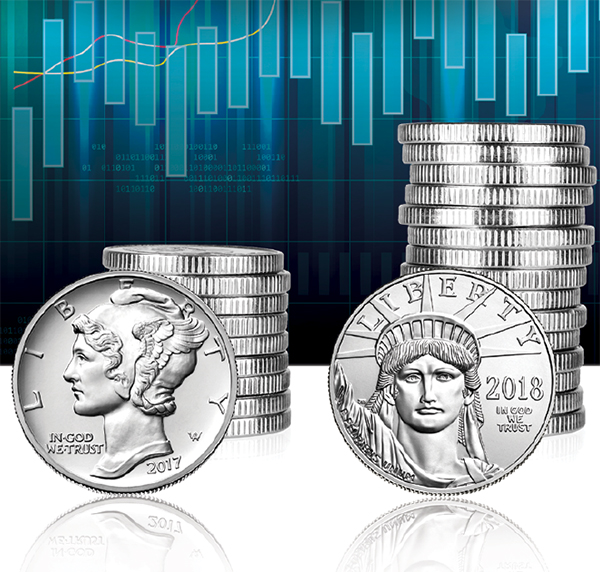
By Steve Voynick

Get with the program. These days, even the U.S. Mint is manufacturing, promoting, and selling coins made from precious metals other than the conventional gold and silver, the most widely touted as investments.
In 1997, for example, the Mint began producing platinum bullion coins in various denominations and weights. And in 2017, the one troy-ounce palladium American Eagle made its appearance, joining the growing array of platinum and palladium investment coins and bars that are now available. The new palladium coin is a member of the American Eagle family, even though its obverse features a high-relief likeness of “Winged Liberty” from the Mercury dime obverse designed by Adolph A. Weinman. The first issue of 15,000 pieces sold out instantly.
A couple of years ago, the well-known “daredevil investor” James Passin researched rhodium and identified it as a candidate for rapid growth. Coin experts John Albanese and Scott Travers took notice of Passin’s analysis, recommended it themselves, and watched rhodium soar from under $800 per troy ounce to close to $2,400 by September 2018. This 300% increase in just two years dramatically illustrates both the inherent price volatility and the investment opportunities offered by rhodium and its sister metals.
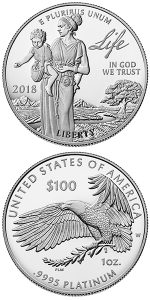
(Image courtesy United States Mint.)
Rhodium, along with platinum, palladium, iridium, ruthenium, and osmium, make up the platinum-group metals (PGMs). These six largely inert, chemically similar metals have silvery-white colors, excellent electrical conductivity, and extraordinary catalytic properties. Because they resist chemical oxidation and retain their luster indefinitely, they are classified with gold as “noble” metals. Given their rarity, high value, and use in jewelry and investment products, the PGMs also qualify as precious metals.
And for the precious metal investor, James Passin and others are now recommending platinum coins and bars, though admittedly not with the same enthusiasm as with the earlier rhodium call. Platinum, the most common and familiar PGM, ranks 71st in crustal abundance (gold is 72nd). It is considerably harder and denser than gold, and its much higher melting temperature makes it more difficult to work. Although not quite as inert as gold, platinum nevertheless resists oxidation to retain its silvery-white color and bright metallic luster. Also unlike gold, platinum and the PGMs rarely occur in economic concentrations suitable for mining.
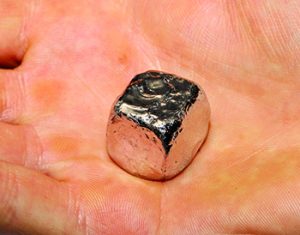
one of the six PGMs. (Image courtesy Wikimedia Commons.)
Gold has been valued since antiquity, but platinum’s story is much different. In the early 1500s, Spanish colonial gold miners found the first important source of platinum in the river placers of what is now Colombia. At the time, the metal had neither use nor value. Furthermore, it was difficult to separate from gold, and its high melting temperature made it virtually unworkable. The Spanish named the metal platina, a derogatory term meaning “little silver,” alluding to both its silvery color and lack of value.
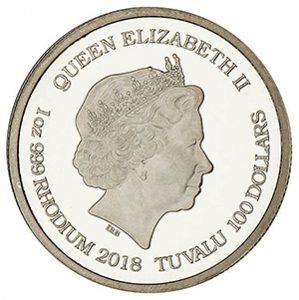
When the Spanish did manage to separate platina from gold, they discarded it as waste. During the early 1600s, workers at the Santa Fé de Bogotá royal mint in the present-day Colombian capital city of Bogotá dumped hundreds of pounds – perhaps even several tons – of platina into the Río Bogotá, where it remained for several centuries.
The Spanish continued to discard platina until 1670, when metallurgists found its first practical use – as an alloying agent to improve the hardness and durability of bronze cannons. Weighing a ton or more, these cannons contained as much as 1% (often more than 20 pounds) of platina.
Then, in the early 1700s, metallurgists learned that adding arsenic to platina reduced the metal’s high melting point and enhanced its workability. They also realized that gold, even when heavily alloyed with platina, changed very little in weight or color, a discovery that led Spanish colonial mint workers to begin adulterating gold coins with platina and pocketing the displaced gold.
To stop this practice, the Spanish Crown banned private possession of platina under penalty of death. When counterfeiting continued, the Crown took another approach, this time offering a bounty for all platina turned in – the first formal valuation of the metal. Ironically, the Crown itself would later resort to counterfeiting by ordering its own gold coinage debased with platina, then using those issues to settle foreign debts.
In the early 1800s, English chemists showed that platina was not a single element as previously thought, but a natural alloy of several elements. After isolating and identifying palladium, rhodium, iridium, and osmium, they named the parent metal “platinum” after platina. Platina’s last elemental component – ruthenium – was discovered and isolated several decades later.

In 1824, Russian gold prospectors in the Ural Mountains discovered the rich Nizhne-Tagilsk platinum placers. The Russian government quickly monopolized platinum mining and refining, and began fabricating and marketing platinum jewelry – which consumers promptly rejected as a cheap
“silver imitation.”
To make use of its growing platinum stockpile, the Russian government then issued legal-tender, platinum ruble coins. In 1828, a 3-ruble coin containing 10 grams of pure platinum made its debut and was soon followed by a 6-ruble, 20-gram coin. Two years later, a hefty 12-ruble coin containing 40 grams (nearly 1.3 troy ounces) of platinum entered circulation.
By 1843, when Russian mints were turning out 100,000 troy ounces of platinum coins each year, the government realized that the number of circulating platinum rubles far exceeded that of its official mint issues. European counterfeiters had been buying nearly worthless Colombian platina and using it to mint bogus platinum rubles. Russia’s platinum coinage halted in 1845 when the metal was no longer considered an investment or a collectible. Platinum coins would not be struck again until the 1970s.
During the 1850s, European scientists began utilizing platinum’s high melting point and chemical inertness in laboratory instruments and crucibles. Growing fabrication demand soon drove platinum’s price to $1.50 per troy ounce – higher than the price of silver.
In the 1890s, researchers discovered that platinum’s catalytic properties could increase the rate of many industrial chemical reactions. Platinum soon became a vital catalyst in many chemical processes, most notably in acid manufacturing and petroleum “cracking.”
At the same time, platinum was also becoming popular as a jewelry metal when Louis Cartier of Paris, Louis Tiffany of New York, and Peter Carl Fabergé of Moscow, the world’s foremost jewelry designers, began creating jewelry that combined platinum’s brilliant, white gleam with the glitter of diamonds and sapphires. Louis Tiffany later used platinum extensively in his popular Art Nouveau jewelry creations.
By 1905, combined jewelry and industrial demand had driven platinum’s price above that of gold (then $20.67 per troy ounce). Breaking the “gold-price barrier” earned platinum worldwide acceptance as a bona fide precious metal.
In 1924, South African geologist Hans Merensky made the greatest PGM discovery ever – layered igneous deposits of PGM-bearing minerals rich enough to justify the cost of deep underground mining. These deposits, the Merensky, Platreef, and UG2 reefs, all part of South Africa’s mineral-rich Bushveld Complex, are still the world’s largest source of PGMs.
As growing South African mine production was lowering the price of platinum, its demand as a jewelry metal increased. By the 1930s, the new Art Deco jewelry style that emphasized platinum became so popular that the value of platinum-jewelry sales began to approach that of gold.
But during World War II, when platinum’s high electrical conductivity, durability, and corrosion resistance became critical in many wartime applications, the United States War Production Board declared the metal a strategic material and banned its use in jewelry.
The PGMs entered the modern era with the passing of the federal Clean Air Act in 1970. This act mandated reductions in automotive-exhaust emissions and required that the millions of new automobiles manufactured each year be equipped with catalytic converters to break down carbon monoxide, noxious hydrocarbons, nitrous oxides, and other exhaust emissions. Each converter now contains roughly one-quarter to one-half troy ounce of platinum, palladium, or rhodium (some contain all three metals) on a ceramic honeycomb called “autocatalyst.”
Growing demand for autocatalyst started a general upward price trend for platinum, palladium, and rhodium that has since fluctuated but never really stopped. Autocatalyst demand for these three metals remains the primary driving force behind their prices today.
As PGM prices rose sharply in the 1970s, South African mines stepped up PGM production, while Russia opened its palladium-rich Norilsk Nickel mines and reopened its old placer mines in the Urals.
Meanwhile, metallurgists and treasure hunters began tracking down many old platina-bronze Spanish cannons displayed in town plazas and ports throughout Latin America, chipping off assay samples to identify “platinum guns,” then acquiring them to sell for their PGM value. And in Colombia, miners returned to the old colonial platina mines and even began sluicing gravels in the Río Bogotá, where Spanish mint workers had dumped their then-worthless platina 300 years earlier.
Platinum coins also made their first appearances since 1845. In 1977, the Soviet Union began issuing one-half-troy-ounce platinum commemorative coins dedicated to the 1980 Moscow Olympics. Platinum coinage continued with various commemorative issues until 1991 and the fall of the Soviet Union. The Russian Federation then minted 16 platinum-coin issues commemorating historical events and Russian art until 1995.
In 1983, the Isle of Man issued the one-troy-ounce platinum Noble, the first PGM investment coin. In 1988, Canada, Australia, and China came out with the platinum Maple Leaf, the platinum Koala, and the platinum Panda, respectively, all in a variety of weights.
The Australian platinum Koala was particularly interesting in that it was available in weights from on-tenth of a troy ounce to one kilogram (32.15 troy ounces), the latter at the time the world’s heaviest bullion coin.
In 1997, the United States joined the platinum-coinage parade with the American platinum Eagle in weights of one-tenth, one-quarter, one-half, and one troy ounce.
As platinum demand grew, PGM mining expanded in South Africa and also became a significant industry in Russia, Canada, and the United States. Because of their mutual chemical affinities, the PGMs always occur together in nature and are mined together. “Platinum mines” are really “PGM mines,” in which either platinum or palladium are the metals of primary economic importance, while the other four PGMs are present in smaller quantities.
Today, 14 million troy ounces of PGMs, mostly palladium and platinum in a 60-40 ratio, are mined worldwide each year. Just four nations account for most of this production. South Africa’s 20 PGM mines, rich in platinum and rhodium, yield 8 million troy ounces each year, or nearly 60 percent of world output.
Russia, where PGM ores are rich in palladium, ranks second with 3.2 million troy ounces, most from the Norilsk Nickel mines, along with smaller amounts from two large placer mines. Canada is third with 1.1 million troy ounces coming from the Lac des Iles palladium-platinum-gold mine and as a by-product of nickel mining.

The United States ranks fourth with 520,000 troy ounces, almost all from Montana’s Stillwater underground palladium-platinum mine. The Stillwater deposit, the world’s richest – but not largest – PGM source, consists of a six-foot-thick, four-mile-long layer grading 0.7 troy ounces of PGMs per ton in a 3.6:1 palladium-platinum ratio. Stillwater, which opened in 1986 and has workings as deep as 2,900 feet, now recovers 388,000 troy ounces of palladium and 116,000 troy ounces of platinum from 1 million tons of mined ore each year.
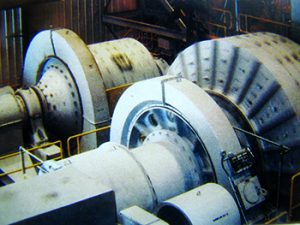
(Image courtesy Stillwater Mining Company.)
Stillwater’s cumulative PGM production now tops 12 million troy ounces, and large ore reserves remain for future mining. But because Stillwater accounts for only 3.5% of global output, the United States, the largest PGM consumer, relies heavily on imported PGMs.
After mining, PGM ores are crushed, ground to a fine powder, and put through a flotation-separation process that yields a PGM-sulfide concentrate. This concentrate is then smelted into a metallic mix of PGMs, which is separated and refined at PGM refineries.
Global PGM demand now tops 18 million troy ounces per year. Autocatalyst accounts for 60% of demand; jewelry manufacturing for 27%; and metallurgical, chemical, medical, and electronic uses for 13%. Specialized PGM uses include chemotherapy drugs for cancer treatment, biomedical devices such as stents and pacemakers, specialty alloys, and fuel-cell catalysts.
The gap between PGM supply and demand is somewhat balanced by 4 million troy ounces of recycled PGMs recovered from scrap autocatalyst, electronics, and jewelry.
Each year, 3 million troy ounces of PGMs, mostly platinum, are made into jewelry. But platinum’s jewelry appeal appears to be somewhat limited. Unlike gold, platinum lacks its own distinctive color. Gold also enjoys a millennia-old tradition as the world’s preferred fine-jewelry metal, while platinum’s jewelry history goes back only about 120 years. It is not surprising, therefore, that 84 million troy ounces of gold are now fabricated into jewelry each year compared with only 3 million troy ounces of platinum.

As investment metals, 99.95% pure platinum and palladium coins and bars in a variety of weights are readily available. Both platinum and palladium have a liquidity approaching that of gold and a steadily increasing demand. They are also much rarer: Only a single troy ounce of platinum is mined today for every 18 troy ounces of gold. Yet gold clearly remains the preferred investment metal. Institutions, governments, and private investors now hold 3 billion troy ounces of gold, compared with just 3 million troy ounces of platinum.
Historically, PGM prices have been more erratic than those of gold, an instability that presents interesting investment opportunities. Currently, the price of platinum is substantially lower than that of gold. As of this writing (November 2018), platinum is worth $860 per troy ounce. Palladium is worth $1,100 per troy ounce; ruthenium, $270; osmium, $400; iridium, $1,485; and rhodium, $2,425. In just the past four years, platinum prices have hit $2,000 per troy ounce, while palladium has bottomed out at $175 and ruthenium has ranged from $40 to $270.
Because platinum and palladium have somewhat interchangeable autocatalytic uses, they often exhibit a “seesaw” relationship between price and demand. When platinum prices are higher, autocatalyst manufacturers often switch to palladium, thus boosting its demand and price, while lowering those of platinum. Every few years, the opposite occurs when palladium prices rise.
As previously noted, rhodium prices are even more volatile. Rhodium, one of the rarest of the PGMs, is particularly effective in catalyzing the breakdown of nitrous oxides in automotive emissions. When rhodium took off on a sharp rise to a remarkable $10,000 per troy ounce in 2007, it became the most precious of the precious metals – only to lose 90% of its value during the 2008 financial crisis.
Rhodium has many uses in autocatalyst, industrial catalysts, fiber optics, crucibles, electrical contacts, jewelry plate, and exotic alloys. Perhaps most importantly for the future, rhodium shows great promise in catalyzing the chemical reactions necessary for solar-energy storage – an area that has long baffled researchers.
Rhodium is now also joining platinum and palladium in metal-investment markets. The Pacific island nation of Tuvalu recently issued the first rhodium coin containing 1 troy ounce of 99.9% pure rhodium. Also available are 1-troy-ounce and 5-troy-ounce rhodium bars.
An interesting way to put historical PGM and gold production into perspective is through physical volume. According to the United States Geological Survey, total PGM production since large-scale mining began in the 1920s is about 440 million troy ounces – a mere fraction of the 7 billion troy ounces of gold that have been mined throughout history. The cumulative gold production would occupy a cube 69.2 feet on a side; all the PGMs ever mined would occupy a cube only 14.2 feet on a side.
Increasing use in industry and growing popularity as investment metals indicate that overall PGM demand will grow, while supply may be restricted by inherent rarity and limited number of mine sources – the likely reasons why Passin and others are now focusing on platinum as a particularly attractive investment opportunity. The PGMs have come a long way since platina, and the best part of their story is yet to come.
Want to receive COINage magazine in your mailbox or inbox? Subscribe today!













Super rare silver coins are SUCH a good investment. I recently saw a morgan worth over $1000. couldnt believe it, seemed like nothing special to me, you never know what you got on your hands until you get it checked out by a PRO